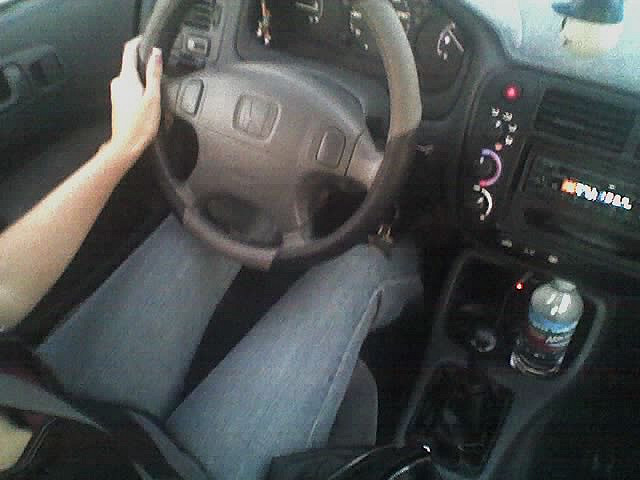
My own driver’s test was long ago, in the state of Hawaii. You can read about the whole harrowing experience here. The tips below are based on teaching our children to drive.
The first thing you need to do is get a learner’s permit. To do that, you go into your local Department of Motor Vehicles (DMV) office and take a written test. They have a booklet available for the material you need to know for the test. If you are pretty good academically, you can probably just flip through the booklet for 30 minutes and still pass the test. My motto is, if you don’t know the answer, pick the most conservative one – that is, always say that the other driver has the right of way. There are many versions of the written test, so chances are that the one you take will not be the same as the one your friends take. But if you want to what it looks like, here’s a sample. Also, this is unsubstantiated, but it seems to me that they give a harder written test if you’re under 18.
When you get your permit, they will take your picture. Be sure that you look good if you care, because that will be the picture on your permanent license later.

The permit is good for one year, and you can then practice driving with your parents or another adult.
When you’re ready, you will have to take a behind-the-wheel road test. At our local DMV’s, an appointment was required for road tests.; you cannot just walk in and take a road test. Since we were seeking an appointment near the end of summer, presumably when all the students want to take their test, it was impossible to get a slot online. What we needed to do was call 1-800-777-0133. It helps to call at 8 am sharp, right when they open, or else you could wait a long time in the phone queue. I first tried the “Make an appointment” selection in the phone menu, but that told me that no appointments were available. I’m guessing that if the online appointments are full, then the automatic phone appointments are full too. What worked was to choose “speak to a technician,” and speak with a human. The person on the other end was able to view the schedules further out than the automated system. At some locations, the first open appointment was 6 weeks in the future. Plan accordingly. Possibly you can get an earlier appointment by looking at other locations near you. For example, our ideal location would have been Los Gatos, but their first opening on Sep 29th. San Jose had availability on Sep 10th. Sometimes people do cancel and slots open up. Right at the DMV, I saw a woman walk in and ask for an appointment, and there was one available for two days later.
When you have your appointment set, start practicing in the area around that particular DMV. It matters, especially if that office is not local to you. For example, Los Gatos has nearby hills, and they may ask you to parallel park on a hill, or there might be a stop sign on a slope. Santa Clara is flat, but has a lot of traffic at lunch time, and you may have to do a challenging lane change in a narrow window. San Jose has a lot of one-way streets, so you might get caught doing a left turn into the incorrect lane, if you don’t know which streets are one-way. San Jose also has high density housing and narrow streets in the area, so you might need to pull over at times to let another car pass, or carefully steer around a garbage cart, or a scavenger looking for recycling. Also, practice at least once in the DMV area at the time of day that your test is scheduled. If your test happens to be when school gets out and traffic is crazy, you’ll be glad that you knew that beforehand.
On the day of the test, arrive a half hour early for your appointment. Don’t drive into the line of cars waiting for the road test, yet. Park elsewhere. Go inside, and go directly to the driver’s test appointment window. The line, if any, should be short, even if the DMV is crowded. You will need to have 4 things with you: your permit, the car’s registration, proof of insurance for the car, and a licensed driver, who will have to show their license. (If you’re under 18, there are additional requirements.) They will quickly check these items, and give you a packet. Then you go back to your car, put the packet on the dashboard, and get into line for the test. TURN OFF YOUR CELL PHONE (don’t just set it to vibrate). If you get a call or text during the test, and even even tap the phone to shut it up, that could be considered using a cell, possibly an automatic fail. See below for other automatic fail items. Also, turn off your radio or any music players, and keep them off for the duration of the test.
Before the actual road test, they will do a pre-test check. Know your hand signals. I saw one woman get marked off for not knowing what the hand signal for “slow” was. They will also check turn signal lights, front and back, and brake lights. If these do not work, they won’t let you take the test, so it’s a good idea to check them yourself the day before. They will ask you to honk the horn to see that it works. The car will need to have working seat belts. I heard rumor that they will disqualify a car that has a check engine light on. Here’s the checklist that they used, both for pre-road check, and the actual test. Pay special attention to the “Critical Driving Error” section on that list. Those are automatic failures, like hitting an object (including the curb), or anything else dangerous. Note that one item says “Auxiliary Equipment” – that might be something like fussing with your cell phone.
During the test, the examiner will not try to trick you or tell you to do an illegal thing, so you can pretty much follow their instructions. However, only do so if it’s safe. If they tell you to merge to the right, but another car suddenly accelerates into that lane, it’s better to miss the merge than try to make it at all costs.
The road test was straightforward at our DMV. It consisted of right and left turns, right and left lane changes, and stop signs. They made our daughter pull over and back up the car in a straight line. They did not ask for parallel parking, although they certainly could if in the mood for it. They did not go onto the freeway.
Additional tips:
- Make full stops. A full stop is when the car stops, and your body recoils, and the recoil stops. Think STOP-one-two. In California, you’ll almost never get ticketed in real life for making a rolling stop at a stop sign, but don’t do it on the test.
- Turn into the correct lane, which is usually the closest lane to you. On a right turn, that’s the rightmost lane, unless there’s a line of cars parked in that lane. Pay special attention to one-way streets, as if you’re making a left turn from a one-way street, you want to start in the leftmost lane, and if you’re making a turn onto a one-way street, you want to end in the leftmost lane.
- Always use the turn signal, both for turns, and lane changes, even if there is no other traffic around.
- Drive smoothly as much as possible. Don’t accelerate, brake, or lane change suddenly, unless there’s a safety issue. Take your turns, especially U-turns, at reasonable speed.
- Keep a good spacing between you and the car in front of you. Not only could you get docked points for tailgating, if the car in front suddenly stops and you have to slam on your brakes, that’s even more points off.
- Check traffic before making any lane changes, turns, or starting up from a stop. They are watching to see if you turn your head and/or look in the mirror appropriately.